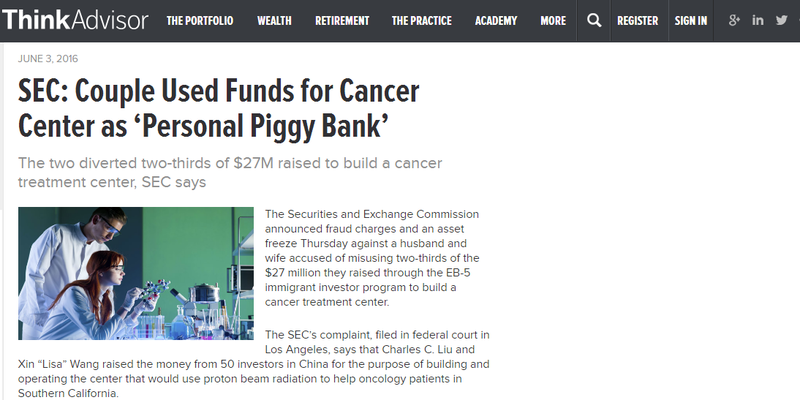SEC: Couple Used Funds for Cancer Center as ‘Personal Piggy Bank’
The Securities and Exchange Commission announced fraud charges and an asset freeze Thursday against a husband and wife accused of misusing two-thirds of the $27 million they raised through the EB-5 immigrant investor program to build a cancer treatment center.
The SEC’s complaint, filed in federal court in Los Angeles, says that Charles C. Liu and Xin “Lisa” Wang raised the money from 50 investors in China for the purpose of building and operating the center that would use proton beam radiation to help oncology patients in Southern California.
The complaint states that they touted in promotional materials that the project would create more than 4,500 new jobs and have a substantial impact on the local economy while giving foreign investors an opportunity for future U.S. residency.
“But presently there is no construction at the proposed site after more than 18 months of collecting investments,” the SEC states. “Liu meanwhile has transferred $11 million in investor funds to three firms in China and diverted another $7 million to his and his wife’s personal accounts.”
The EB-5 visa program grants residency to foregners who invest at least $500,000 in a business that creates at least 10 jobs in certain areas. The SEC and the Financial Industry Regulatory authority have said that they are scrutinizing the program, in which attorneys are often caught acting as unregistered brokers.
In granting the SEC’s request to freeze the assets and accounts of Liu, Wang and related entities, the court’s order prohibits them from raising further money from investors or spending remaining funds.
“We allege that Liu and Wang are using investor funds as their personal piggy bank and exploiting Chinese residents who were assured they were investing in an innovative project to create jobs and cure cancer patients,” said Michele Layne, director of the SEC’s Los Angeles Regional Office.
One of the websites Liu and Wang have used to promote investments in the cancer center project includes a section entitled “Government Support” with photos of former president George Herbert Walker Bush and former California governor Arnold Schwarzenegger, the SEC complaint states.
“Their photos are accompanied by what appear to be letters they wrote in support of proton therapy in general rather than the depicted EB-5 project, which had not even been initiated at the time the letters were written.”
The SEC’s complaint names Liu and Wang along with the companies behind the EB-5 project: Pacific Proton Therapy Regional Center, Pacific Proton EB-5 Fund, and Beverly Proton Center LLC. They are charged with violating antifraud provisions of Section 17(a) of the Securities Act of 1933 and Section 10(b) of the Securities Exchange Act of 1934 and Rule 10b-5.
The SEC seeks preliminary and permanent injunctions as well as the disgorgement of ill-gotten gains plus interest and penalties.
Mentions
- Pacific Proton Therapy Regional Center
- UNITED STATES SECURITIES AND EXCHANGE COMMISSION
- FINRA - Financial Industry Regulatory Authority
- Charles Liu
Litigation Cases
States
- California
Videos





Subscribe for News
Site Digest
Join Professionals on EB5Projects.com →
Securities Disclaimer
This website is for informational purposes only and does not constitute an offer or solicitation to sell shares or securities. Any such offer or solicitation will be made only by means of an investment's confidential Offering Memorandum and in accordance with the terms of all applicable securities and other laws. This website does not constitute or form part of, and should not be construed as, any offer for sale or subscription of, or any invitation to offer to buy or subscribe for, any securities, nor should it or any part of it form the basis of, or be relied on in any connection with, any contract or commitment whatsoever. EB5Projects.com LLC and its affiliates expressly disclaim any and all responsibility for any direct or consequential loss or damage of any kind whatsoever arising directly or indirectly from: (i) reliance on any information contained in the website, (ii) any error, omission or inaccuracy in any such information or (iii) any action resulting therefrom.



